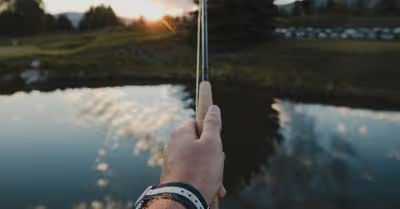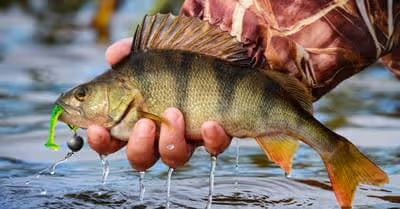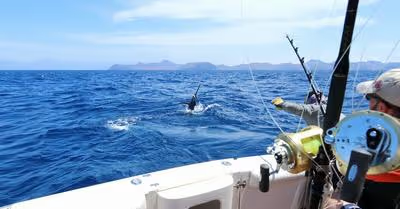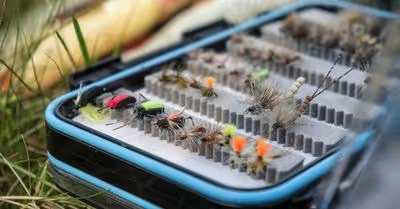Table of Contents
What is a baitcaster?
A baitcaster is just like a normal reel except that it has a revolving spool. Additionally, unlike normal reels, a baitcaster sits on top of the rod. This is because it improves the gearing and reduces drag. That’s how a baitcaster can achieve such long casts compared to a standard reel. Baitcasters come with triggers too, to improve efficiency. Overall, using a baitcaster can be far easier than a normal reel. Hence their popularity.
What are the advantages of using a baitcaster?
Because of their clever design, baitcasters are capable of holding a heavier line and casting farther out than ordinary reels. This increases our opportunities for fishing in multiple ways:
First, the line is less likely to break from catching a bigger, stronger, fish. Losing your line and your prized catch is painful, by having a baitcaster you improve your odds massively.
Second, the longer casts mean you can improve your reach greatly increasing your odds of catching something. It also means you can fish deeper down should you want to. If you are deep-sea fishing, this is a must.
The stronger line means it isn’t as likely to get caught up and break in heavy weeds. You will be able to be braver with your fishing locations opening up the possibility of catching different fish than you might otherwise be able to with a normal reel. It can help keep things interesting for you.
How to cast a baitcaster
Learning to cast a baitcaster can be tricky at first, but with practice, you will get the hang of it in no time at all. The benefits of using a baitcaster are huge, learning to use one properly will quickly pay off. Both enjoyment wise but also financially. Baitcasters allow you to use heavier lines so they are far less likely to break. Meaning you are far less likely to need to replace your line, hooks, lures, and sinkers. Here are the 10 easy steps to help you start fishing using a baitcaster like a pro.
#1 – Make sure the rod you are using is capable of using a bait caster. If you are using a short, light, rod you are going to break it. The ideal rod is about six and a half to seven feet long; medium to heavy. The heavier the better. Stick to what makes you comfortable, if you prefer a smaller lighter rod six and a half feet and a medium is about perfect.
#2 – The heavier your line the easier time you will have learning to cast. The best weight is about 15 pounds for beginners. Once you have got the hang of it you can be more flexible with your choices of line. The reason a heavier weight line is better to learn with is it is far less likely to end up in a bird’s nest, also known as backlash.
#3 – Each baitcaster will have its optimal settings. What these are is for you to find out. You can either do this by looking at the manufactures website or by using the instruction manual. You will want to set the correct drag and spool tension. The good thing about baitcasters is that they don’t have as much trouble with drag as normal reels. So you might get a bit of leeway here.
#4 – First, you want to check the tension of your line, The best way to do this is to hold your rod straight out so it is as horizontal as possible. Then press the spools trigger with your thumb and watch as the lure and sinker fall. They should fall steadily, not rapidly. If they fall too quickly you need to consult your manual and make adjustments to your baitcaster.
#5 – When you cast, you want to bring your rod back over your shoulder. Whichever side is most comfortable for you, with one hand on the trigger ready. If you have the rod over your right shoulder it is best to use your right hand on the trigger.
#6 – Push your thumb down on the trigger. Once you press down the line will immediately start to release, so be prepared to cast out. If you press the trigger too early you will cast out and your line will get tangled.
#7 – Aim at your target before you cast. You should have a clear idea where you are trying to cast before you let go. This is so you don’t cross lines with someone or worse hurt them. When first learning it is best to pick a marker off in the distance and aim for that. The goal here is to just cast the correct direction not hit a specific target.
#8 – Keep your trigger pushed down until your line starts to lose momentum. When you are starting to reach the end of your cast slowly release the trigger until it comes to a stop. If you release the trigger too early the line will potentially break from the sudden stop.
#9 – Once you have released the trigger begin to reel your line in once or twice so the anti-reverse engages. This stops a fish pulling your line out when you get a bite. If you are just practicing feel free to reel it back in and try again from step 5.
#10 – Keep practicing. Over time this will all become second nature to you. Like all things, practice makes perfect.
Conclusion
Hopefully, this article has given you all the tips needed to learn how to use a baitcaster. Baitcasters are great fun to use, once you overcome the initial hump of re-learning how to cast out you will be perfectly fine. If you are still struggling, there are so many great tutorials on YouTube, such as this one:
Recent Articles
















